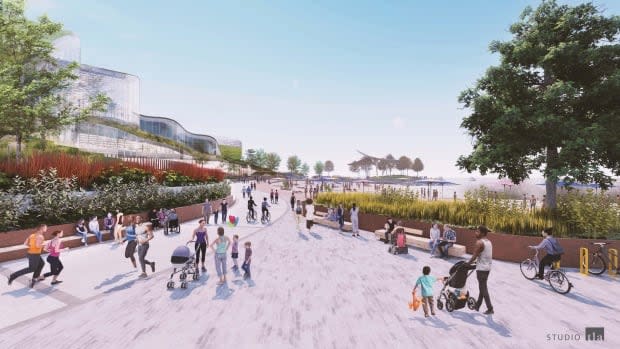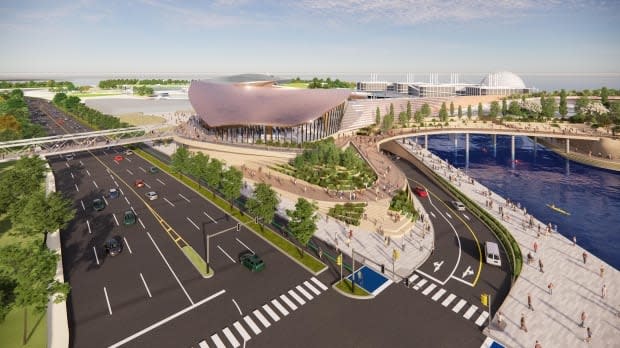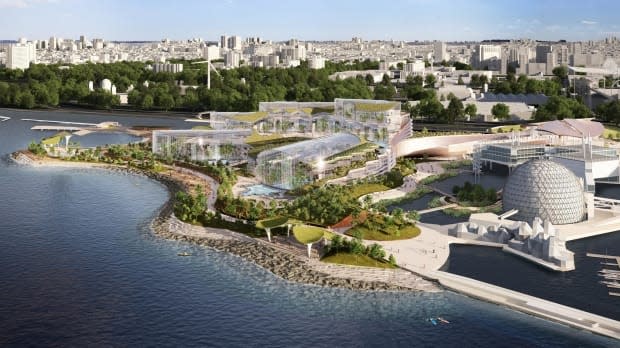Ontario Place plans are being reviewed by the city. But some urge Toronto to look at other options

Toronto is reviewing plans to turn Ontario Place into a sprawling private water park and spa with underground parking for more than 2,000 vehicles — a project that would require nearly 850 trees on the grounds be cut down.
City staff and council are currently examining a development application submitted by the province on Nov. 25. The controversial proposal has been in the works for more than a year and needs to be approved by the city to move ahead.
Some advocates and elected officials have raised concerns about the future of the decommissioned waterfront park, pointing to what they say is a lack of public and green spaces in the plans given the original vision for the site.
Here is a breakdown of the proposed development that has sparked opposition from community groups:
What is being proposed?
Therme Canada — the Canadian arm of an Austrian company — wants to build an indoor water park and spa complex on the west island. The development was designed in partnership with STUDIO tla, a landscape architecture firm, and would include nearly 12 acres of public spaces consisting of parkland, gathering areas and a beach.
The private facility would feature "state of the art" pools, saunas, gardens, thermal baths and sports therapy services with indoor and outdoor spaces on the west island and mainland.
Therme says the project would turn the 155-acre waterfront attraction, first opened in 1971 but closed in 2012 after years of declining attendance, into a "a world-class year-round destination for all."
According to the plans, a "wetland innovation zone" would manage run-off so the lake water around the development would be clean enough to provide new habitat for native birds, fish and other wildlife.

The acres of public space were added to the design after backlash over the idea that valuable lakefront land would be leased exclusively to a private company. The additions came with input from the public and the Mississaugas of the Credit First Nation.
"This is a concept that we think will animate the west island in such a way that provides the opportunity for enjoyment across four seasons," said Mark Lawson, vice president of communications and external relations at Therme Canada.
"It's the kind of thing that will draw people from across the city, around the province and frankly, we think, all over the country and around the world."
The most recognizable elements and green space of the old Ontario Place would be preserved. Last year, the province said it will be retaining many of the "key heritage and recreational features," including the iconic Cinesphere, the pod complex, the marina, Trillium Park and the William G. Davis Trail.
The site would also include a redeveloped and expanded Budweiser Stage concert venue, while the aging Cinesphere and pod structures will be refurbished.
Multi-storey underground parking, felling of 846 trees
The province would cover the costs of a multi-storey underground parking structure to accommodate more than 2,000 vehicles, a detail reported by the Globe and Mail earlier this month. CBC Toronto asked Infrastructure Ontario for further details of the parking structure, including the cost and whether it will fall on taxpayers.
"Parking arrangements will be confirmed pending the outcome of the ongoing City of Toronto review," said ministry spokesperson Andrea B. Chiappetta in a statement.
In addition, 846 of the site's existing trees would need to be felled to make way for the new buildings, according to the development application.
"Some of the trees down there are actually in quite poor condition and we also know that we're dealing with a soil erosion situation down there and with contamination to that soil," Lawson said.
"There's no question that [by] taking a largely abandoned site, we need to make it a destination for millions of Ontarians and that's going to mean earth moving works and that will of course affect trees on site."

Norm Di Pasquale is the co-chair of the advocacy group Ontario Place for All, founded in January 2019 after the province's initial announcement of its plans for the site.
"City council have debates that take hours over one tree being cut down [and] we're talking about 846 trees that are roughly 50 years old that we are going to lose," Di Pasquale told CBC Toronto.
"This is a time where we have to be preserving our tree canopy, not eliminating it. It's the wrong move."
Di Pasquale said the group vehemently opposes the province's current direction for the project.
"Unlike what the province has put forward, public interest, not commercial interest, must drive the new vision," he said.
Why the opposition?
Coun. Ausma Malik, who represents Ward 10 Spadina–Fort York, says it's important that the redeveloped land includes ample green space that's open and accessible to all residents and guests to the city.
"The proposal that we see in front of us raises a lot of concerns around being able to meet those objectives," Malik said. "From what we've seen so far, the public access … the green space is not sufficient."

Malik said Therme's proposed facility, estimated to cost around $350-million, is "a terrible use of taxpayer dollars on public lands.
"We could invest that money to build an exceptional public park that's available for everyone to use and enjoy, and to be that generational project that Ontario Place was in its original inception," she said.
"What we have right now, thanks to the collective advocacy of community organizations through the development application process, is an opportunity for the public and the city to do a much more thorough review of the proposal."
Di Pasquale said the "recreational and wellness facility," at nine storeys tall, would "dwarf" the rest of Ontario Place.
"The spa is going to essentially swallow up the west island … it's going to be 45-metres tall, which is about half the size of the Skydome," Di Pasquale said.
"Bill Davis, the Progressive Conservative premier in the 70s intended this to be a backyard and a cottage for Ontarians who don't have such a thing," he said. "So I think we need to re-zoom into that vision and really fight to protect what is 'Ontario's place.'"

Mayor John Tory previously said he wants the redeveloped site to be accessible for everyone and that he is awaiting the results of the city review.
Rexdale a good alternative location, says former mayoral candidate
Chloe Brown, a former mayoral candidate and policy analyst at Toronto Metropolitan University, said the proposed spa would be better built in Rexdale, in a location with ample parking and close to Pearson airport.
"Ontario Place should be an outdoor park. It doesn't make sense to me that we're gonna add a spa on the lake to get access to the water," Brown told CBC Radio's Metro Morning this week.
"It's very counterproductive and it's not great value for money."
LISTEN | Brown discusses her alternative vision for the Ontario Place grounds:
The province has said the new venue would boost the city's economy, and is projected to welcome four to six million visitors per year in addition to creating 3,600 new jobs.
When would construction work start?
The project is forecast to take roughly 10 years to complete, with construction on the site set to start in the west and move eastward.
"We'd love to have a shovel on the ground in the fourth quarter of 2024," Lawson said.
Gregg Lintern, Toronto's chief planner, said the planning division will engage with the province in the process, which will require "timely information sharing and the ability to have public consultation on the application and meaningful responses to issues identified as a part of the established development review process."
City staff are expected to make a recommendation to council by the end of 2023.


